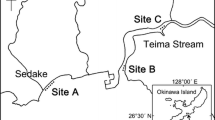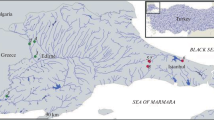Abstract
Larvae of many odonate species commonly appear within the same freshwater ecosystem. However, it remains unknown whether there is a dietary separation among the larvae of different species. In this study, we collected different species of odonate larvae in different seasons at various sites on the floating mat of Mizorogaike Pond in Kyoto, Japan, and examined the abundance and gut contents of the dominant species. Our analyses showed that habitat and seasonal abundance of the odonate larvae did not significantly overlap between most pairs of the dominant species. Moreover, the degree of dietary overlap was not related to larval biomass in microhabitats. These results suggest that, although larval food habits were similar among species, the existence of various vegetation types on the floating mat allowed many odonate species to inhabit Mizorogaike Pond.





Similar content being viewed by others
References
Abekura K, Hori M, Takemon Y (2004) Changes in fish community after invasion and during control of alien fish populations in Mizoro-ga-ike, Kyoto City. Glob Environ Res 8:145–154
Aoki J (2015) Pictorial keys to soil animals of Japan, 2nd edn. Tokai University Press, Tokyo
Baker RL, Clifford HF (1981) Life cycles and food of Coenagrion resolutum (Coenagrionidae: Odonata) and Lestes disjunctus disjunctus (Lestidae: Odonata) populations from the boreal forest of Alberta, Canada. Aquatic Insects 3:179–191
Benke AC (1978) Interactions among coexisting predators—a field experiment with dragonfly larvae. J Anim Ecol 47:335–350
Blois C (1985) The larval diet of three anisopteran (Odonata) species. Freshw Biol 15:505–514
Bried JT, McIntyre NE, Dzialowski AR, Davis CA (2015) Resident-immigrant dichotomy matters for classifying wetland site groups and metacommunities. Freshw Biol 60:2248–2260
Chase JM, Leibold MA (2003) Ecological niches: linking classical and contemporary approaches. Univ Chicago Press, Chicago
Cheng YC, Lin CP (2016) Dietary niche partitioning of Euphaea formosa and Matrona cyanoptera (Odonata: Zygoptera) on the basis of DNA barcoding of larval feces. J Insect Sci 16:73
Chesson J (1978) Measuring preference in selective predation. Ecology 59(21):1–215
Cloarec A (1977) Alimentation de larves d’ Anax imperator Leach dans un milieu naturel (Anisoptera: Aeshnidae). Odonatologica 6:227–243
Corbet PS (1980) Biology of odonate. Annu Rev Entomol 25:189–217
Crowley PH, Johnson DM (1982) Habitat and seasonality as niche axes in an odonate community. Ecology 63:1064–1077
Dolédec S, Chessel D, Gimaret-Carpentier C (2000) Niche separation in community analysis: a new method. Ecology 81:2914–2927
Elkin CM, Baker RL (2000) Lack of preference for low-predation-risk habitats in larval damselflies explained by costs of intraspecific interactions. Anim Behav 60:511–521
Febria CM, Magnusson AK, Williams DD (2005) Seasonal abundance and prey selection of the nymphs of three sympatric species of Sympetrum (Odonata: Libellulidae) in an intermittent pond. Can Entomol 137:723–727
Folsom TC, Collins NC (1982) Food availability in nature for the larval dragonfly Anax junius (Odonata: Aeshnidae). Freshw Invertebr Biol 1:33–40
Fujita N (2008) Vegetation and water quality. In: 7 Men’s Editorial Board of Mizorogaike (ed) Nature and human lives in and around Mizorogaike Pond. Sunrise Co., Ltd, HIkone, pp 161–163 (in Japanese)
Galbreath GH, Hendricks AC (1992) Life history characteristics and prey selection of larval Boyeria vinosa (Odonata: Aeshnidae). J Freshw Ecol 7(2):201–207
Griffiths D (1970) Observations on the food of dragonfly nymphs from a bog water in north Norway. Entomol Mon Mag 106:41–47
Harabiš F, Tichanek F, Tropek R (2013) Dragonflies of freshwater pools in lignite spoil heaps: restoration management, habitat structure and conservation value. Ecol Eng 55:51–61
Ishida S, Ishida K, Kojima K, Sugimura M (1988) Illustrated guide for identification of the Japanese Odonata. Tokai University Press, Tokai
Johansson F (1993) Intraguild predation and cannibalism in odonate larvae: effects of foraging behaviour and zooplankton availability. Oikos 66:80–87
Johnson JH (1995) Diel feeding ecology of three species of aquatic insects. J Freshw Ecol 10:183–188
Johnson DM, Crowley PH (1980) Habitat and seasonal segregation among coexisting odonate larvae. Odonatologica 9:297–308
Kato Y, Takemon Y, Hori M (2009) Invertebrate assemblages in relation to habitat types on a floating mat in Mizorogaike Pond, Kyoto, Japan. Limnology 10:167
Kawai T, Tanida K (2005) Aquatic insects of Japan: manual with keys and illustrations. Tokai University Press Division, Tokai
Khelifa R, Zebsa R, Moussaoui A, Kahalerras A, Bensouilah S (2013) Niche partitioning in three sympatric congeneric species of dragonfly, Orthetrum chrysostigma, O. coerulescens anceps, and O. nitidinerve: the importance of microhabitat. J Insect Sci 13:71 (Tokai University Press Division)
Koshikawa MK, Fujita N, Sugiyama M, Hori T (2005) Distributions of pH and chemical components in Mizorogaike, a pond with a floating-mat bog. Limnology 6(1):27–37
Lamoot EH (1977) The food of the damselfly larvae of a temporary tropical pond (Zygoptera). Odonatologica 6:21–26
Larson DJ, House NL (1990) Insect communities of Newfoundland bog pools with emphasis on the Odonata. Can Entomol 122:469–501
Legendre P, Legendre LF (2012) Numerical ecology, vol 24. Elsevier, New York
Leibold MA, Holyoak M, Mouquet N, Amarasekare P, Chase JM, Hoopes MF, Holt RD, Shurin JB, Law R, Tilman D, Loreau M, Gonzalez A (2004) The metacommunity concept: a framework for multiscale community ecology. Ecol Lett 7:601–613
McCauley SJ, Davis CJ, Relyea RA, Yurewicz KL, Skelly DK, Werner EE (2008) Metacommunity patterns in larval odonates. Oecologia 158:329–342
McPeek MA (1990a) Behavioral differences between Enallagma species (Odonata) influencing differential vulnerability to predators. Ecology 71:1714–1726
McPeek MA (1990b) Determination of species composition in the Enallagma damselfly assemblages of permanent lakes. Ecology 71:83–98
McPeek MA, Schrot AK, Brown JM (1996) Adaptation to predators in a new community: swimming performance and predator avoidance in damselflies. Ecology 77:617–629
Merrill RJ, Johnson DM (1984) Dietary niche overlap and mutual predation among coexisting larval Anisoptera. Odonatologica 13:387–406
Mizuno T, Takahashi E (1991) An illustrated guide to freshwater zooplankton in Japan. Tokai University Press, Tokai
Mori M, Kitayama A (2002) Dytiscoidea of Japan, (revised edition). Bun-ichi Sogo, Tokyo
Morikawa M, Aizawa A, Kobayashi T (2013) The litter supply regulates the structure of the dragonfly larva community. J Japan Soc Reveget Technol 39(1):15–20
Narita K (2008) Odonate in Mizorogaike pond. In: Men’s Editorial Board of Mizorogaike (ed) Nature and human lives in and around Mizorogaike Pond. Sunrise Co. Ltd., HIkone, 55–56 (in Japanese)
Ozono A, Kawashima I, Futahashi R (2012) Dragonflies of Japan. Bunichi-Sogo, Tokyo Google Scholar
Paterson MJ (1994) Invertebrate predation and the seasonal dynamics of microcrustacea in the littoral zone of a fishless lake. Archiv Für Hydrobiologie 1–2:1–36
Pritchard G (1964) The prey of dragonfly larvae (Odonate, Anisoptera) in ponds in northern Alberta. Can J Zool 42:785–800
Seifert LI, Scheu S (2012) Linking aquatic and terrestrial food webs–Odonata in boreal systems. Freshw Biol 57:1449–1457
Shimamura T, Takemon Y, Osaka K. I, Itoh M, Ohte N (2007) Spatial distribution of nitrate in Mizoro-ga-ike, a pond with floating mat bog. In: Advances in geosciences, volume 6. pp 129–137
Siepielski AM, Mertens AN, Wilkinson BL, McPeek MA (2011) Signature of ecological partitioning in the maintenance of damselfly diversity. J Anim Ecol 80:1163–1173
Stoks R, McPeek MA (2003) Antipredator behaviour and physiology determine Lestes species turnover along the pond-permanence gradient. Ecology 84:3327–3338
Tabata H (2008) Woody plant species on the floating mat. In: Men’s Editorial Board of Mizorogaike (ed) Nature and human lives in and around Mizorogaike Pond. Sunrise Co. Ltd., HIkone, 159–160 (in Japanese)
Tanaka M (2002) Illustrations of the Japanese freshwater plankton. Nagoya University Published, Nagoya
Thompson DJ (1978) Prey size selection by larvae of the damselfly, Ischnura elegans (Odonata). J Anim Ecol 47:769–785
Tsujino R, Fujita N, Katayama M, Kawase D, Matsui K, Seo A, Shimamura T, Takemon Y, Tsujimura N, Yumoto T, Ushimaru A (2010) Restoration of floating mat bog vegetation after eutrophication damage by improving water quality in a small pond. Limnology 11(3):289–297
Ueno S, Kurosawa Y, Sato M (1985) The Coleoptera of Japan in color (II). Osaka Childcare Company, Osaka, p 514
Werner EE, Anholt BR (1996) Predator-induced behavioral indirect effects: consequences to competitive interactions in anuran larvae. Ecology 77:157–169
Acknowledgements
The authors thank Drs. Y. Kato and T. Kazama for their encouragement, Mr./Ms. Y. Kimura, Y. Sakai, Y. Matsutani, and M. Fukagawa for their help with field work, and Dr. M. Kyle and two anonymous reviewers for their fruitful comments. We are also grateful to the Preservation of Cultural Properties Section, City of Kyoto, for permission to undertake the research. This study is partially supported by a Grant-in-Aid for Scientific Research (KAKENHI 16H02522).
Author information
Authors and Affiliations
Corresponding author
Additional information
Handling Editor: Fabio Lepori.
Electronic supplementary material
Below is the link to the electronic supplementary material.
Rights and permissions
About this article
Cite this article
Yamada, S., Tsujino, R., Takemon, Y. et al. The role of spatial and temporal variations in habitat uses and food habits of larvae in persistent occurrence of multiple odonate species in Mizorogaike Pond, Kyoto, Japan. Limnology 20, 181–190 (2019). https://doi.org/10.1007/s10201-018-0564-0
Received:
Accepted:
Published:
Issue Date:
DOI: https://doi.org/10.1007/s10201-018-0564-0




